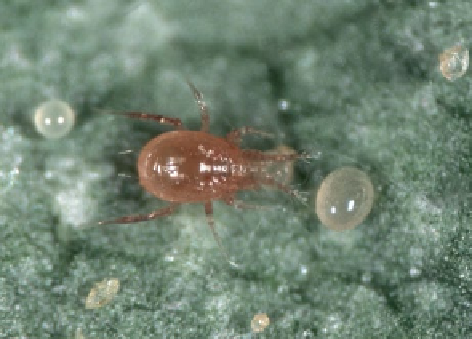Agriculture Reference
In-Depth Information
Fig. 15.6
Phytoseiulus persi-
milis
, a predatory mite for the
control of red spider mite that
has been a major contribution
to the reduction of pesticides
in flower production in
Kenya
There are many other factors which impact on ecological change that Lake
Naivasha has undergone in the last 100 years. The introduction of exotic species,
such as the common carp (
Cyprinus carpio
) has resulted in all fish being exotic, the
arrival of water hyacinth (
Eichhornia crassipes
) and the oscillating natural flora
populations (Harper et al.
2011
). The use of geothermal energy generation using
the lake water has increased. Introduced in 1981, the first geothermal plant was
commissioned and by 1985, a total of 45 megawatt (MW) of electricity was be-
ing generated in the area. The increased human activity has also resulted in illegal
fishing, cattle access and defecation, and the degradation of the lake shore vegeta-
tion. The buffalo population has increased three-fold in the lake zone. Increased
small-scale agriculture has contributed to erosion and lake sedimentation. Finally
a weakness in the governance of these interacting factors has contributed to the
lack of resolution of the challenges facing Lake Naivasha. In 2005 legislation sup-
ported the establishment of the Water Resources Management Authority in Kenya
and they were charged to form the Lake Naivasha Water Resource Users' Asso-
ciation (LNWRUA). Through the initiative of the LWRUA and others, community
based water resource management has led to the successful management of Lake
Naivasha water abstraction and pollution. However, the question of alien species
has had limited attention (Harper et al
2011
). The increased awareness of the lake's
challenges with local communities and international organisations is also likely to
bring on-going benefit.
The arguments for and against the airfreight of flowers from Kenya are the same
irrespective of the country they are being sent to. Airfreight is a contributor to rising
levels of GHGs, global warming and climate change. In addition there are argu-
ments that the transport of virtual water from a country such as Kenya may cause
drought (Chapagain and Orr
2009
). However the position about airfreight and horti-
cultural trade is often misrepresented and over simplified within the environmental
debate.
The consumer in Northern Europe who wants to purchase roses as a cut flower
has two options. Firstly they can buy those grown locally, which would have been

